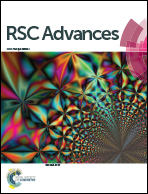Facile one-step fabrication of upconversion fluorescence carbon quantum dots anchored on graphene with enhanced nonlinear optical responses
Abstract
A novel nanocomposite hybrid, carbon quantum dots (CQD)/graphene oxide (GO), which combines the favorable optical properties of both its components, is synthesized by a facile one-step electrochemical method. Transmission electron microscopy, Raman spectroscopy, UV-vis spectroscopy, and fluorescence studies show that the CQDs uniformly attach on the GO surface, which enables highly efficient energy transfer between CQDs and GO. The nonlinear optical and optical limiting (OL) performances are investigated by the open-aperture Z-scan technique in the nanosecond regime using a laser with a wavelength of 532 nm. The as-prepared CQD/GO composite offers a significantly improved OL performance compared with GO because of the charge/energy transfer process between the CQDs and GO. The main contributors to the enhanced OL effect in the CQD/GO hybrid are a combination of nonlinear scattering and increased nonlinear absorption resulting from efficient charge/energy transfer at the CQD/GO interface.



 Please wait while we load your content...
Please wait while we load your content...